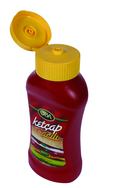Dare to be different
13 January 2011A fully functional closure does much more than open and close; protecting the product, extending shelf life and impressing consumers is only part of the story, writes Joanne Hunter.
To increase market share, pursue expansion into emerging geographic markets, or just to keep up current business levels, it is important to meet the needs of consumers and the supply chain. Secondly, to be ahead of the game and catch the competition unawares, manufacturers must be resourceful in terms of design and technology, give vent to the imagination, if necessary reach deep into the pocket, and simply have the nerve to be first with a new idea. In other words, dare to be different.
contact
To secure a higher price point, every element of a product must signpost ‘quality’. Carbery cheeses, made in Ireland for retail and food service applications, recently integrated a resealable closure on its flagship brand Dubliner, ‘to reinforce its premium nature’. The Zip-Pak DoubleZip was chosen for added seal security and ease of use.
“Since packaging represents the first interaction with Dubliner, it enhances a consumer’s experience with the brand,” confirms Alan Smith, Area Sales Manager at Zip-Pak Europe.
DoubleZip features two sets of interlocking profiles strategically spaced to guide the fingers along a path, ensuring complete bag closure. Especially for oxygen-sensitive products such as cheese and meat, the dual profiles promote freshness by locking out air and environmental contaminants. For ease of implementation, the system can be made to run on ‘virtually all’ horizontal and vertical form/fill/seal machinery.
Zip-Pak is also targeting meat, fish and poultry, which in the European packaged foods market accounts for 15.9% of total packaged food sales. In meat, the risks of spoilage caused by oxidisation are high, and potentially dangerous, and resealable packaging with an airtight zipper can keep product fresher and extend fridge-life, claims the company.
Aplix recommends its reclosable system made from food grade polyethylene for flexible packaging in the cheese, sliced meat and frozen foods sectors and also for petfoods and the garden sector. The ‘self-mating micro-hooks’ take less pressure to open and close a pack because precise alignment is not needed. In a consumer study by Leatherhead Food Research in the UK, 80% of respondents felt the system was ‘the easiest type of packaging for the whole family, including children and elderly people’, reports Aplix.
Meanwhile, the Pactiv Slide-Rite pack continues to make its mark in the UK for larger volumes of 20kg or more. The bags can be made of plastics, paper or polywoven materials and the slider can be easily added to form/fill/seal lines, the company says. Using it now are Pedigree for dried dog food, Birds Eye for bags of frozen vegetables and Tilda for rice. Slide-Rite packs have also been chosen for dishwashing powder and fertiliser.
Bapco Closures has produced a finger-pull welded foil barrier membrane that its UK launch partner, the retailer Marks & Spencer (M&S), calls a ‘truly an innovative step for the UK market’. Based on the company’s patented BAP Technology, the Twister closure combined with a plastics container by RPC Group has made the packaging for M&S pickled foods 80% lighter than a jar it has replaced. The two-part injection moulded packaging is completed with an overcap and spout with an integrated fused foil laminate. After filling, the closure is positioned and induction welded into place.
Explaining its benefits, Neil Fowell, Sales and Marketing Director at Bapco Closures, says: “As there is no vacuum holding theovercap in place it can be removed extremely easily, while a unique easy grip spiral ring pull mechanism means that the force required to open the foil closure is notably reduced.” Bapco more recently has signed a partnership with international company Aptargroup to help distribute the BAP Technology used in the closure across Europe. The welded foil closure was originally designed to stop milk bottles leaking and has since been adapted to improve pack functionality, says Bapco. BAP Technology found its first successes in North America, and the brands Del Monte and Tropicana have made the transition in the past two years.
Safety, especially for young children, is uppermost in the minds of closure suppliers.
“Due to the requirements of the market, specifically of the USA, regarding choke-proof systems for children under three years old, IPN developed a choke-proof cap for its line of Clean Spout technology,” says Luis De la Mora, Director of Sales and Marketing at IPN USA. “The current cap fits all of IPN's 10.6mm spouts and can be adapted to fit other spout diameters, including 8.5mm. The design takes into consideration the need for achieving a low weight cap with a flange that passes the requirement for choke-proof legislation. The cap is available in HDPE and PP and can be moulded in any colour.”
IPN believes its ‘low-cost’ Clean Valve Aseptic fitment offers added convenience across all ages and product categories in the beverage market. Designed to avoid spills, the pouch closure requires only light suction to initiate a flow. This makes it perfect for children's drinks, sports drinks and for the elderly, says IPN.
The concept is based on a ‘unique’ valve incorporated into the spout. The aseptic guarantee is maintained by an aluminum seal on the bottom of the spout. By removing the overcap, the seal is pierced automatically. As the valve is opened, it allows the liquid to pass through the valve. As soon as the suction stops, the valve closes and so does the flow. Apparently, this spout will not spill even when the pouch is squeezed.
It is said to be ‘revolutionising’ the use of flexible pouches for beverages produced on a full aseptic in-line pouch production and filling machine (aseptic HFFS). Both the film material and the closure are sterilised in-line.
Easy and cheaper final disposal increasingly is elemental to the successful take-up of new products. Bericap introduced into the Turkish market a mono-material hinge closure with a valve function for ketchup and mayonnaise, to help overcome recycling issues and reduce cost by avoiding the use of silicon. The valve can be part of a one-piece closure, or a second piece can be inserted into the closure made of the same plastic material.
So while the closure mechanism may be physically a relatively small component, it plays a huge role in making sure packaging performs to its utmost potential.
Viewpoint on European closures
More than 120 delegates from the UK, Europe and Asia overcame bad weather and transport disruption to attend December 2010’s Plastics Caps and Closures two-day conference in Brussels. Stephen Wilkins, of Stephen Wilkins Associates and Chief Executive of the UK’s Child-Safe Packaging Group joined a panel discussion on end user and brand owner expectations of supply partners, alongside Filip van Geel, Principal Researcher at Procter and Gamble, and Gregory Bentley, Packaging Innovator - Design & Development Europe at Coca-Cola. In an exclusive report for Packaging Today he writes: .
“Sustainability was the order of the day and Filip and Gregory spoke about the tremendous strides their organisations had made, and were making, in this area. I was glad to cite UK based Gwalia Packaging Group’s lightweight child resistant closure, deriving its functionality from patented soft hinges. Weighing one gramme less than its nearest competitor, it can save a bleach manufacturer 100 tonnes of polymer each year, which drives the point home: better design means less material and ultimately less cost.
“A highlight for me was Canadean’s Dominic Cakebread and his resume´ of market behaviour to date, and his prognostications for the period to 2015. And Keld Krogh Nielsen, of Georg Menshen, demonstrated his own invention, the One 2 Dose, a closure with a measured dose dispenser, which has been promoted by a TV ad sponsored by the Danish Government.
“Several papers dealt with materials and none was more effective than David Mann’s work with thermoplastic elastomer (TPE). It has all the processing characteristics of plastics with the feel and malleability of rubber; the possibilities for closure manufacturers are endless, as David pointed out.
“For my part, I talked on the difficulties of openability and the problems of ageing. There are 11 million people in the UK with low vision and who need spectacles. As packaging manufacturers we must recognise that they are a vital section of our market and we need to design for them accordingly.”
Bapco Closures’ finger-pull welded foil barrier membrane launched in North America and now in the UK and Europe. Bapco Zip-Pak’s DoubleZip guides the fingers along a path for ‘complete bag closure’. Zip-Pak IPN developed choke-proof caps for its Clean Spout technology. IPN Bericap’s hinge closure with a valve for ketchup and mayonnaise is designed for easier recycling. Bericap Stephen Wilkins. Stephen Wilkins






